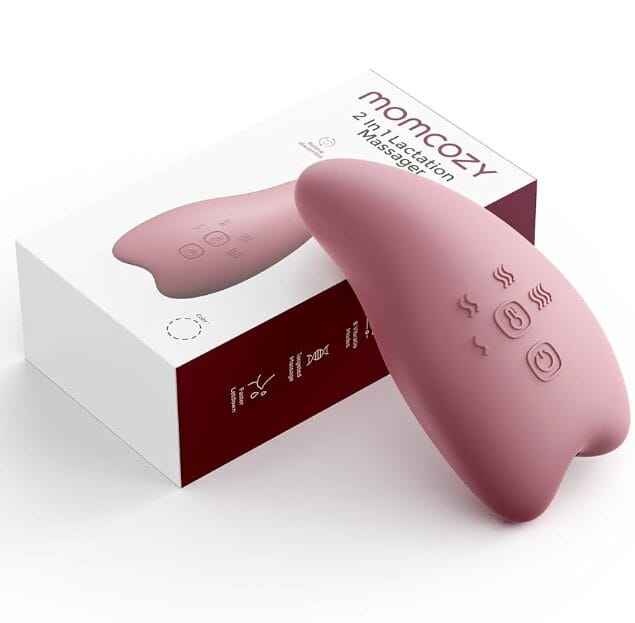Breast engorgement can be one of the most uncomfortable challenges a new mom faces, especially in the early days of breastfeeding. When your breasts become overly full, swollen, or painful, it can make feeding difficult for both you and your baby. Fortunately, breast massage to relieve breast engorgement is a gentle, effective way to ease the pressure and restore comfort — all while improving milk flow.
For moms looking for an easier and faster way to relieve engorgement, using the Momcozy breast massager can be a game changer. Designed to mimic natural hand massage and stimulate milk flow through heat and vibration, it helps soothe tenderness and prevent clogged ducts safely and efficiently.

What Is Engorgement and Its Causes
Engorgement happens when your breasts become overly filled with milk, blood, and lymphatic fluid. It typically occurs within the first few days after giving birth — when your milk “comes in” — but it can also happen later if you skip feedings or your baby suddenly reduces feeding frequency.
Common causes include:
- Infrequent nursing or pumping – Skipping sessions allows milk to build up.
- Poor latch or ineffective milk removal – If your baby isn’t draining the breast properly, milk can accumulate.
- Weaning too quickly – Stopping breastfeeding abruptly can cause engorgement.
- Sudden changes in feeding patterns – Longer sleep stretches at night or returning to work may trigger it.
The condition causes swelling, firmness, and pain. Breasts may feel warm, look shiny, and the areola may become tight, making it difficult for the baby to latch.
Without proper management, engorgement can lead to blocked ducts or mastitis, so early relief is key.
The Key Difference Between Fullness and Engorgement
It’s normal for your breasts to feel full when milk production increases — this fullness is temporary and usually subsides after feeding. Engorgement, however, goes beyond simple fullness.
Here’s an easy comparison:
Breast Fullness
- Feels heavy or firm
- Usually improves after feeding
- Skin feels soft and pliable
- Baby can latch easily
Breast Engorgement
- Feels hard, swollen, and painful
- May persist even after feeding
- Skin feels tight and stretched
- Baby struggles to latch due to tension in areola
Understanding the difference helps you respond appropriately — and one of the most effective responses to true engorgement is targeted breast massage.
Why Massaging the Lymphatic System Is Step One
Before focusing on milk ducts, it’s important to begin with the lymphatic system. The lymphatic network helps drain excess fluid and reduce swelling in your breast tissue. When your breasts are engorged, lymphatic circulation slows, adding to the pressure and pain.
Starting with lymphatic drainage massage prepares your breasts for easier milk flow by easing fluid buildup. Think of it as clearing the pathway before releasing the milk.
Here’s how to begin:
- Find a comfortable position — Sit or recline slightly, ensuring your back and arms are supported.
- Warm up your breasts — Apply a warm compress or use your Momcozy breast massager on the heat mode for 2–3 minutes to relax tissue and improve circulation.
- Gentle strokes — Using your fingertips, lightly stroke from the outer areas of your breast (near your armpit or collarbone) toward the center of your chest.
- Repeat rhythmically — Continue these strokes for about 2–3 minutes per breast.
This technique helps remove excess lymphatic fluid and reduces swelling, making it easier to express milk afterward.
The Step-by-Step for Engorgement Relief Hand Massage
Once lymphatic massage has reduced initial swelling, move on to a deeper, milk-release massage. This technique helps move milk from the glands toward the nipple, relieving pressure and restoring normal flow.
Step 1: Prepare and Relax
- Wash your hands thoroughly.
- Apply a warm compress or use your Momcozy breast massager for gentle heat and vibration. This encourages milk let-down and softens breast tissue.
- Take a few deep breaths to help your body relax — tension can inhibit milk release.
Step 2: Support the Breast
Place your hand under your breast for support. With your other hand, use your fingertips or knuckles to apply light, circular pressure around the outer part of the breast.
Step 3: Massage Toward the Nipple
Starting from the outer edges of your breast, move your fingers in a circular motion toward the nipple. Use steady, gentle pressure — never press too hard, as this can bruise the tissue.
You can visualize it as “sweeping” milk toward the nipple to ease fullness. Rotate your hand around different areas to ensure all milk ducts are massaged.
Step 4: Gentle Compression
Cup your breast with one hand above and one below, then apply gentle compressions, pressing inward and releasing slowly. This mimics the baby’s sucking motion and helps push milk out naturally.
Step 5: Express Milk if Needed
If your baby isn’t ready to feed, you can manually express milk or pump a small amount to relieve pressure. Continue gentle massage while expressing for best results.
Step 6: Finish with Cool Compress
After feeding or expressing, apply a cool compress for 5–10 minutes to minimize swelling and reduce discomfort.
Beyond Hand Massage: Breast Massagers
While hand massage is effective, many moms find it tiring or time-consuming — especially when dealing with frequent engorgement. This is where technology lends a helping hand.
The Momcozy breast massager is designed specifically to support milk flow and ease engorgement through warmth and vibration. Its ergonomic shape fits comfortably against the breast, providing consistent stimulation across all areas, even those hard to reach with your hand.
Key benefits include:
- Efficient relief: The combination of gentle vibration and soothing heat improves circulation and helps break up hardened milk areas.
- Hands-free use: You can place it inside your bra while nursing or pumping, making multitasking easy.
- Faster milk let-down: The warmth triggers oxytocin release, promoting quicker and smoother milk flow.
- Clog prevention: Regular use helps prevent plugged ducts and mastitis.
Many moms use their Momcozy breast massager before feeding or pumping to prepare the breasts and after sessions to ensure complete drainage.
Tips for Safe and Effective Massage
To make your breast massage sessions safe and beneficial, keep these best practices in mind:
- Be gentle: Avoid using excessive pressure. Massage should never cause pain or bruising.
- Stay consistent: Regular massage (2–3 times daily during engorgement episodes) helps maintain milk flow and prevent recurrence.
- Hydrate and rest: Adequate water intake supports milk production and tissue recovery.
- Feed frequently: Nurse or pump often to keep breasts from overfilling.
- Combine warm and cool therapy: Warmth before feeding encourages milk flow, while cool compresses afterward reduce swelling.
Conclusion
Engorgement can make breastfeeding feel overwhelming, but with the right approach, it’s completely manageable. Performing breast massage to relieve breast engorgement can dramatically reduce pain, improve milk flow, and prevent complications like clogged ducts.
Starting with gentle lymphatic strokes and progressing to full milk-release massage can bring quick relief. For even greater comfort and efficiency, the Momcozy breast massager offers a modern, mom-friendly solution. Its soothing heat and vibration not only help relieve engorgement but also support overall breastfeeding success.
The Editorial Team at Healthcare Business Today is made up of experienced healthcare writers and editors, led by managing editor Daniel Casciato, who has over 25 years of experience in healthcare journalism. Since 1998, our team has delivered trusted, high-quality health and wellness content across numerous platforms.
Disclaimer: The content on this site is for general informational purposes only and is not intended as medical, legal, or financial advice. No content published here should be construed as a substitute for professional advice, diagnosis, or treatment. Always consult with a qualified healthcare or legal professional regarding your specific needs.
See our full disclaimer for more details.







